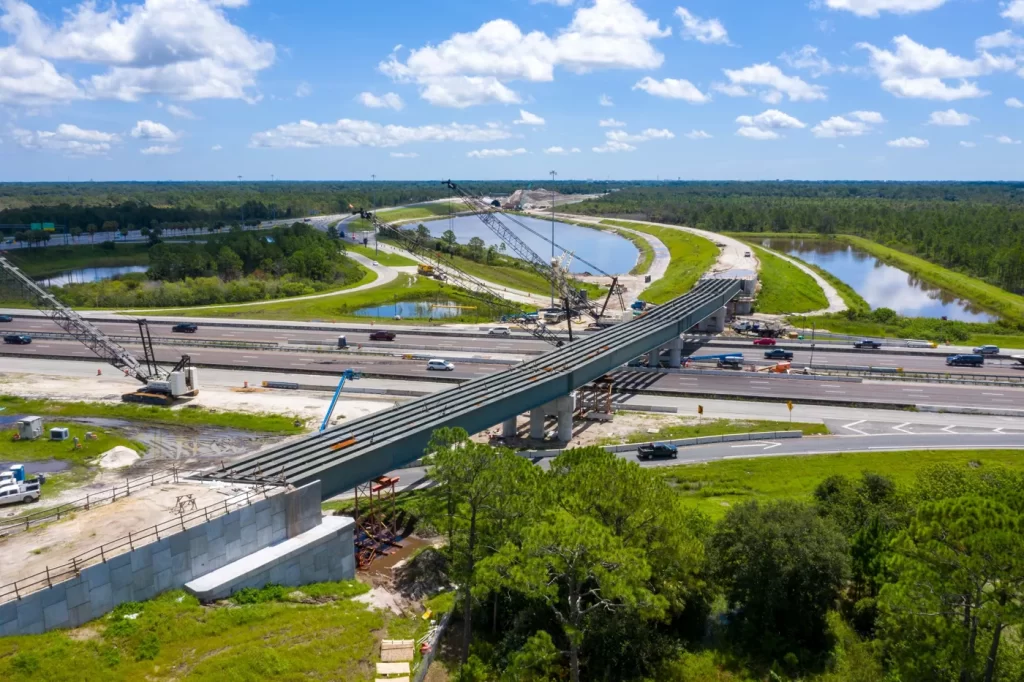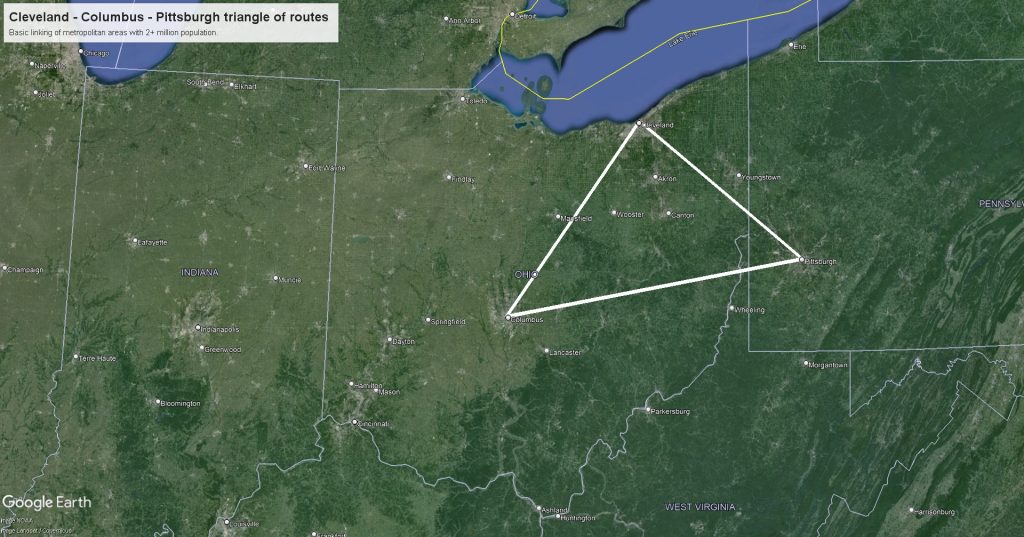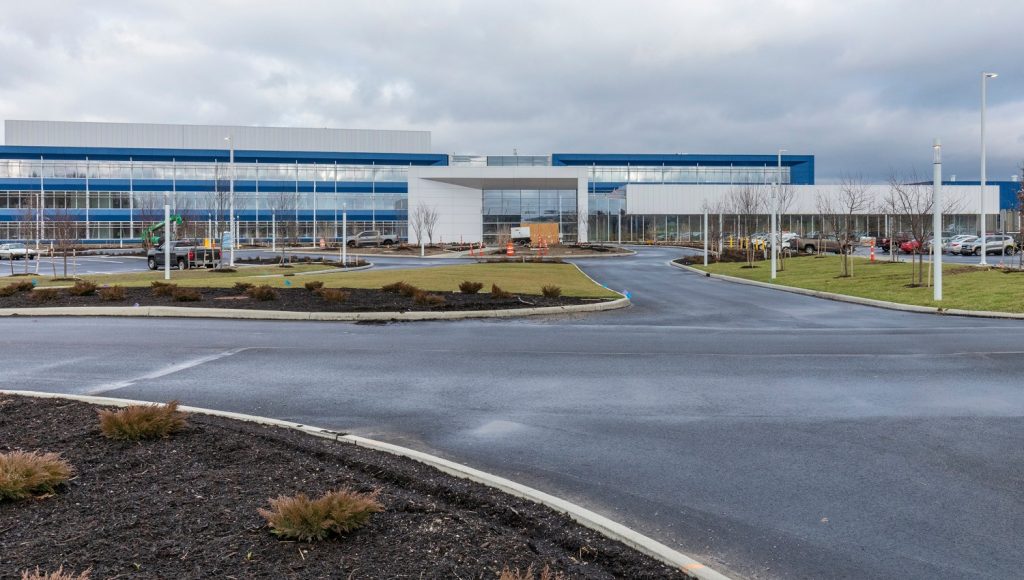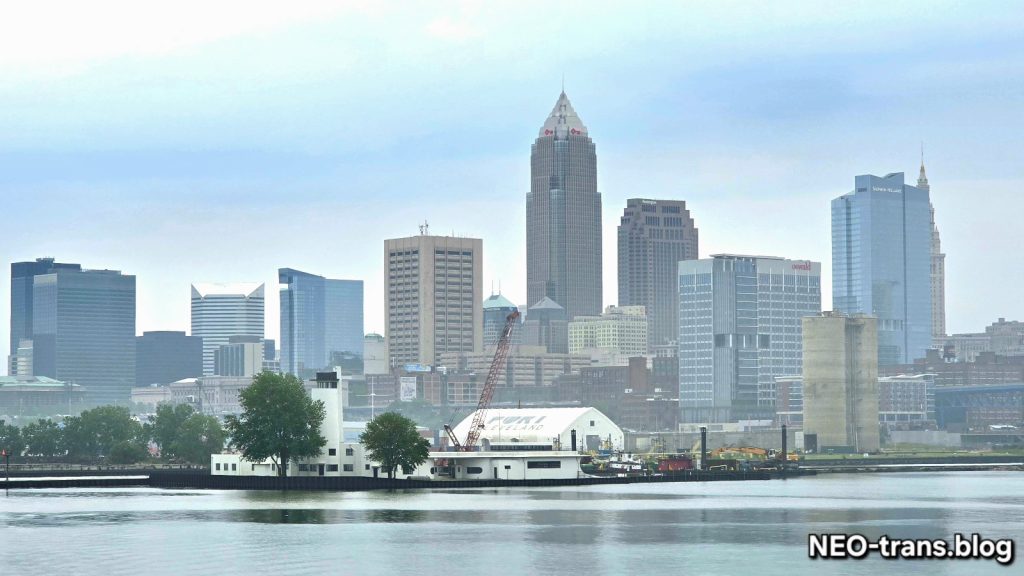
Passenger rail development in the USA is picking up speed. One of the newest rail services is Florida’s Brightline, linking Miami and Orlando by utilizing existing rail and highway rights of way and attracting 4,600 riders per day. Here, a Brightline train pulls up to a new station in Aventura, FL (Google). CLICK IMAGES TO ENLARGE THEM.
Historic routings, neglect complicate Akron-Canton
A COMMENTARY
Last week, a bipartisan group of Ohio Congresspersons wrote to Ohio Department of Transportation (ODOT) Director Jack Marchbanks asking his department to include an Akron-Canton-area station stop in its upcoming passenger rail development plans. Those plans for Northeast Ohio include potential new Amtrak services from Cleveland to Toledo and Detroit, as well as from Cleveland to Columbus, Dayton and Cincinnati (3C&D).
“An (Akron-Canton) Amtrak stop would better connect the workers and families of Eastern Ohio to economic, educational, and healthcare opportunities across the state and the region,” Ohio Congressional delegation members wrote on June 14. “Failing to provide such infrastructure would undoubtedly result in adverse consequences for the economic development of the region.”
Signing the letter were U.S. Reps Emilia Sykes (OH-13), Marcy Kaptur (OH-11), Joyce Beatty (OH-03), Dave Joyce (OH-14), Shontel Brown (OH-11), and Greg Landsman (OH-01).
That letter was the result of outreach by the Akron-Canton Advocacy Alliance, a joint effort by the chambers of commerce for the Greater Akron and Greater Canton regions. Together, this consolidated region has 1.1 million people, 60,000 college students and major employers including three Fortune 500 companies. Those merits were expressed by the alliance in its own letter to ODOT on May 10.
“Ensuring the Akron-Canton region has an opportunity to be included in Ohio’s proposed Amtrak expansion plans is something our stakeholders feel strongly about, and we’re ready to collaborate on next steps,” the alliance noted in its letter.
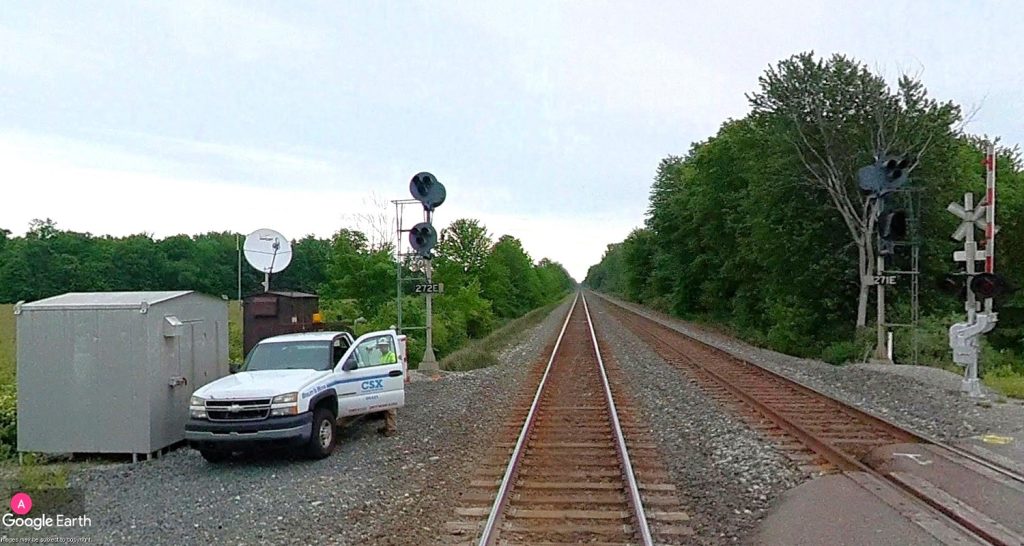
The 3C&D Corridor crosses Biggs Road just outside of Lagrange in Lorain County. CSX freight trains zip through here at 70 mph on well-maintained, seamless welded rails and managed by an interactive, satellite-based traffic control system. With some modest improvements, passenger trains could travel even faster on these direct tracks southwest of Cleveland (Google).
As a passenger rail advocate of 40 years, including a dozen years as executive director of All Aboard Ohio, it’s great for me to see Ohio Congresspersons and business leaders speak up for the development of modern, competitive rail services. I wish we had more interested persons like you back when I was involved!
Ultimately, my advocacy flame burned out while watching Ohio’s neighbors to the east, west and north develop and enjoy what I had hoped Ohio would pursue. At the same time, Ohio lost more and more rail lines to neglect, including some that were once hosts of proud passenger rail services that could be again, albeit in a 21st-century way.
A few of those rail lines were in the Akron-Canton region. And most of those rail rights of way are publicly owned by a locally controlled entity — namely the Akron Metro Regional Transit Authority. Akron Metro owns more than 50 miles of rail lines, extending from the urban core of Akron to Hudson, Kent and Canton.
Under its ownership, two of those three lines were neglected to the point they can no longer be used by trains. Only the 23-mile Canton route is still usable but not for long. The 10.5-mile portion between McCann Plastics on Mayfair Road near the Akron-Canton Regional Airport north to Goodyear Chemicals/Synthomer at Archwood Avenue in East Akron hasn’t seen a train in years. Nature is steadily reclaiming it.
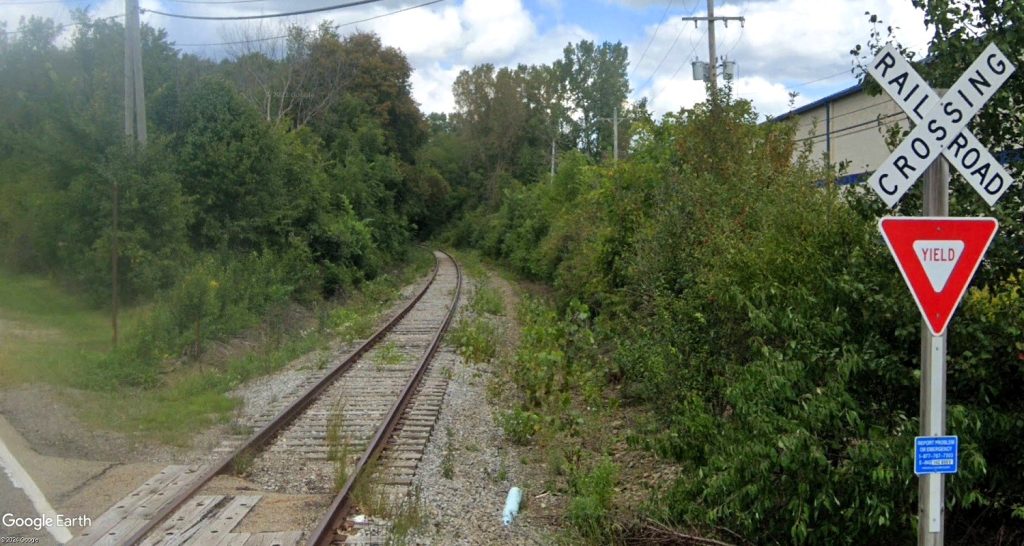
Tracks owned by Akron Metro Regional Transit Authority were being reclaimed by nature at Mayfair Road near the Akron-Canton Regional Airport back in September 2021. From here north to East Akron, encroaching vegetation and the rust atop the railheads have gotten thicker from disuse since then (Google).
When it acquired the rail rights of way, Akron Metro had hoped to deploy them as commuter rail routes. Two studies, one in 1995 and another in 2002, showed commuter rail between Cleveland, Akron and Canton would attract enough ridership to be feasible. In 1996, the Ohio Rail Development Commission was ready to request $60 million in state capital budget funds to develop CAC commuter rail and 3C passenger train services.
Back then, transportation projects were a lot cheaper. Unfortunately, then-Gov. George Voinovich’s Chief of Staff Paul Mifsud berated ORDC at its public commissioners meeting where it would have voted on the capital budget request. “Are you in outer space?” Mifsud yelled at ORDC’s commissioners who backed down. Mifsud later went to prison on corruption charges.
Instead, Akron Metro staff had hoped to attract local rail freight service to its tracks to create new jobs for the region and preserve the rail lines. But none of its proposed development initiatives it considered in 2012 were embraced by its board, in part because it feared a NIMBY backlash in communities like Silver Lake, located along the Akron-Hudson line.
And since freight rail wasn’t a prime function of a transit authority, the agency had to endure lots of federal red tape to get anything done. Doing anything productive with those tracks was considered more of a bother to many on the transit board. So the tracks disappeared under vegetation and, at road crossings, under pavement.
Other factors working against Akron-Canton in getting on either the 3-C and Cleveland-Pittsburgh passenger rail routes were geography and history. Draw a triangle linking the 2 million metro population centers of Cleveland, Columbus and Pittsburgh and you’ll see that Akron and Canton are in the center, not along a direct line between the three points.
Of course, railroads don’t always follow direct lines. They follow topography and customers. Dayton is a perfect example. The main railroad line between Columbus and Cincinnati was built by the Cleveland, Cincinnati, Chicago & St. Louis Railway (Big Four) through Dayton which was a growing manufacturing center during the railroad building boom from 1850-1880. The 125-mile line via Dayton remains because it was designed for speed along flat, wide river valleys.
A competitor, the Pennsylvania RR, followed much of the Big Four route but turned southward at Xenia. Most of this line is gone now. A third competitor, the Baltimore & Ohio, built the most direct route between Columbus and Cincinnati via Washington C.H., the biggest city enroute. The line still exists but is not maintained to passenger standards and is only 7 miles shorter than the route via Greater Dayton’s 1 million people.
Akron grew up thanks to the rubber industry, but it came after the 19th-century railroad building boom was over. So no mainline railroads were built to link Cleveland, Akron and Canton. Its best Cleveland-Akron-Canton link wasn’t a heavy-duty railroad but an electric interurban, the Northern Ohio Traction & Light (NOT&L). Its evolving rail line was adding 80-mph sections to it when the Depression hit.
New Deal-era politics forcing the separation of electric and railway operations, plus the government spending on paved roads but not rails doomed NOT&L. Route 8 north of Hudson to Northfield was built on one of NOT&L’s high-speed sections. Its brick Macedonia station at Route 82 still stands.
The National Park Service-owned tracks leased to the Cuyahoga Valley Scenic Railroad are another option, but not a competitive one. Back when Baltimore & Ohio ran several daily passenger trains over this curvy line, their maximum speed was 50 mph. Operating at that speed or even faster runs counter to the purpose of the Cuyahoga Valley National Park which is to preserve the natural setting and support heritage tourism, notably of the Ohio Canal era.
The Cleveland, Akron & Columbus Railroad that became part of the Pennsylvania System would be a good routing — if it was still around. But south of Hudson, the railroad is gone. Portions of other lines could be stitched together to link Akron with Columbus or Canton with Columbus. But if that’s done with trains originating from Cleveland, it’s problematic.
When 3C&D was last pursued, prior to former Gov. John Kasich giving back $400 million in federal construct funds for 79 mph trains (plus millions more for planning work to increase speeds to 110 mph), an Akron routing was considered. The circuitous routing was found to add an hour to the trip time. It was projected to lose more Cleveland riders than it would gain from Akron. It would increase operating and capital costs for less revenue. The numbers worsened for a Canton routing.
Although neither Akron or Canton worked for 3C&D service using existing railroad rights of way, it could work either for a system approach, or by completely rethinking our rail system in the northeast quadrant of Ohio.
To create a system, it starts by building a roughly 400-mile foundation of service called “the triangle” serving 7.48 million people among Cleveland, Columbus and Pittsburgh. With it, 3C&D runs direct on the existing mainline tracks. Add to that routes directly linking Cleveland and Pittsburgh, plus Columbus and Pittsburgh.
Built on the foundation is “the grid.” The grid adds to the triangle a Cleveland-Akron-Canton regional commuter rail service with urbanized lifestyle hubs built around stations, plus two more Columbus-Pittsburgh routes — one via Akron and another via Canton. The grid has about 675 miles of routes and would serve the maximum number of people, 8.58 million.
But if money were no object and we wanted to consider something truly transformative, we’d pursue “the star” approach. This start-from-scratch high-speed rail system offers an efficient design that promotes greater convenience and use of rail on fewer routes. Three routes would extend outward from a hub at Canton — to Columbus, Cleveland and Pittsburgh.
In other words, all trains would go through Canton and two-thirds of all trains would operate on any one line. The result is high-frequency service on a system of just 230 miles serving a population of 7.79 million people. And since we would build this new, we’d build it for speed so that both the Canton-Pittsburgh and Canton-Columbus legs are traveled in one hour or less. The Canton-Cleveland portion could be traveled in 30-45 minutes, including enroute station stops.
Amtrak might have an interest in that but so would Brightline and possibly others. Brightline built a new 79-125 mph hourly passenger service linking Miami and Orlando using both existing railroad and highway rights of way in a state with politics like ours that also gave back federal rail money in 2011. Brightline has now started building a 200 mph high-speed line in the median of Interstate 15 between Las Vegas and the LA Basin.
Both Amtrak and Brightline are interested in Ohio. Perhaps something will finally get built here. But whatever it is, the first route is going to leave out deserving places that really want it. The initial service isn’t going to be everything to everyone right away because there’s never enough money to get it all at once. It’s going to be an evolutionary process for Ohio to join its neighbors in developing a modern rail system and creative job hubs at stations.
Let me conclude by thanking the Congressionals and the Akron-Canton Advocacy Alliance for speaking out and speaking up. Keep it up and keep contributing to the process. In the near term, allow me to suggest protecting and activating the region’s endangered, locally owned rail assets because it’s really hard to get them back once they’re gone.
END

